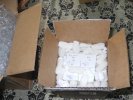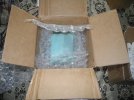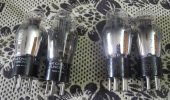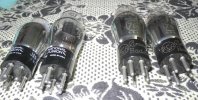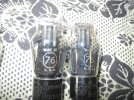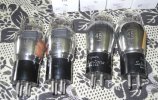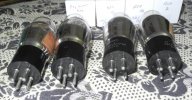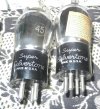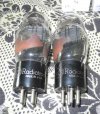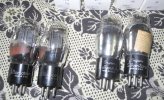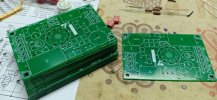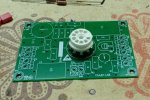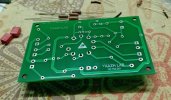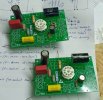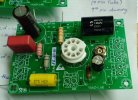Tube Amplifier and Tube pre-Amplifier Builds
- Thread starter radium7
- Start date
reubensm
Well-Known Member
sure, coming out well, watching with great curiosity.
johnmicheal
Active Member
Great work
K&K Audio USA has a high-quality Power supply and shunt regulator for Tube, they work very well in the tube pre-amplifier.
K&K Audio USA has a high-quality Power supply and shunt regulator for Tube, they work very well in the tube pre-amplifier.
Almost the preamp section completed, have to start amplifier section work. The Transformers work not finished, but the transformers can be fixed during finishing. The chassis doesn't have great finish, it will be covered by properly finished outer cover. while attaching this preamp to main amp the cables will be tied properly.
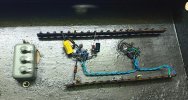
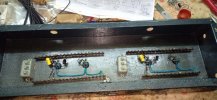

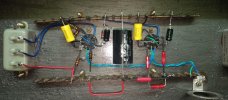
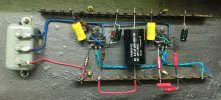
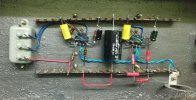
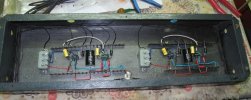
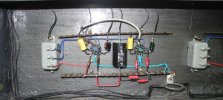
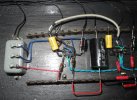
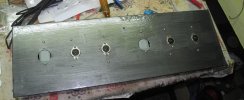










I cleaned and reused the old lug strips for this amp. For new lug strips we have to import, i can't find any good lug strips here in india. According to customer need i select the cabinet material- Mild steel, SS, Aluminium, Copper. My cabinet works are done by a electrical panel box manufacturer.Nice job on amp radium7. Where did you sourced tag strip ? What is cabinet material ? mild steel ? Did you fabricate it at metal press ?
Thanks and Regards
Recently i rebuild a 6L6 tube push-pull amplifier, capable of delivering 35W+35W in ultra linear mode. Originally the amp has ECC88 as driver tube and the circuit is build in a PCB. The circuit is simple and not impressive, but the power and Output transformers are very good. So i change the circuit alone keeping the transformers. power supply board and chassis. I uses the ECF80 tube as driver tube, which has a pentode and triode section. Pentode act as AF Amp, Triode as phase splitter and 6L6 tubes in the output stage. I followed a slightly altered Russian circuit. Removed the PCB and made point to point wiring, with some good quality components. Uses french made solen polypropylene caps for coupling, i feel polypropylene or mylar caps are best for this type of push pull power amps. Without any alteration we can use EL34 tubes instead of 6L6 in this amp.
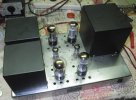
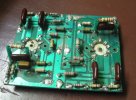
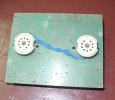
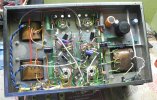
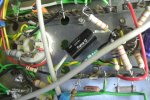
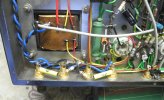
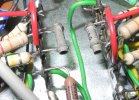
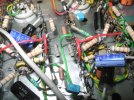
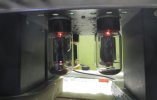
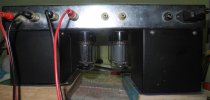
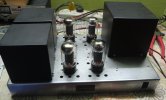
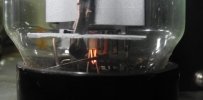












The reason I selected wooden chassis frame
in my DIY tube amp over MS was to avoid chassis resonance. I also wanted to use a brass base and brass top but brass sheets are super expensive. Again for the same reason of lower resonance. I may use a brass sheet at the top to fix the tubes and OPT.
in my DIY tube amp over MS was to avoid chassis resonance. I also wanted to use a brass base and brass top but brass sheets are super expensive. Again for the same reason of lower resonance. I may use a brass sheet at the top to fix the tubes and OPT.
yogitashwer
Member
Hello what is the cost of this amp.Instead of opening several threads, I will post all my Tube related projects in this one. Hope this will be useful for other DIYs and members. I’m posting the information after I tested and confirmed. I welcome fellow members to share their ideas and comments.
The Christiansen "DG" 300B Amplifier
I’m building this Amp for a FM. You can find all details of this amp in their website.
It consists of a Power supply board, Driver board, Maida HT regulator board, Filament regulator boards- 3 nos
The power transformer is a custom made one. The output transformers are from Onetics ltd, USA.
Input transformer from Jensen Transformers. The input stage with transformer is the best and i like this type of circuits.
In the first stage the preamp tubes are LED biased. Negative bias output stage.
We planned to build this amp in wooden chassis with top cover 14 SWG Copper sheet, back and bottom covers are MS sheets.
Almost the construction of the amp is completed, except the 5V filament regulators for 300B tubes not yet received. waiting for it
.View attachment 29071
View attachment 29073
View attachment 29074
View attachment 29075
View attachment 29076
View attachment 29077
View attachment 29078
View attachment 29079
View attachment 29080
View attachment 29081
For this amp Customer supplied all the components, i build cabinet, assemble it, run, tested and complete it as an amplifier. So don't know the exact price, the approximate cost may be around Rs.1.2L. Now this design is discontinued. Any 300B design with imported OPT and good quality components will cost above 1L.
yogitashwer
Member
This going to be very good.
On the 300B amp, there are a few things you can do, to get better performance,........... for free.
1) Cut off all the tie wraps, where you have bundled wires, and throw them in the garbage. The tie wraps forces the fields of the tightly positioned wires to minutely interact with each other, and it rob's the circuit of it's best possible fidelity. The better the amp, and the better the audio system, the more this is evident. Wires should have space between them, even 1/8th of an inch, not touch, and cross at right angles to each other. This should make sense, if you are told and think about it.
2) You need to reposition the input RCA jacks. They are on the wrong side of the amp. You want input wiring to be no more than 2 to 3 inches long, from the RCA jack's center pin, to the grid of the input tube, or, in your case, the input of the Jensen Input transformer.
- - - - - - - - - - - - - - - - - - - - - - - - - - - - - - - - - - - - - - - - - - - - - - - - - - - - - - - - - - - - - - - - -
A general comment, tube amps that are low in overall sensitivity, should be avoided, as they will lack what is called " jump factor ". Obtaining a high input sensitivity, by going to a three stage SE amp , is always a design mistake. Why? Very simple, in my honest opinion, the extra ( middle ) stage loses information, no matter how well it is executed. This leaves us with two stage single ended or push pull tube amps, as always being the very best amp configuration possible.
Amps without a high " jump factor " sound slow and less mentally involving to hear, they have to be pushed to sound decent. What about low level listening? Well, they score C-, D+.
How much gain should one have, in a two stage tube amp, to have a decent " jump factor "??? Good question. Taking the rated ( and not made-good actual ) mu ( gain ) of the two tubes, if they multiply to about 400, you are in good shape. Less is a loss of jump factor !!!
How does one apply this, in real life tube amp design terms ? Well, a mu of 4 ( rated ) 2A3 needs a mu of 100 driver tube. Half a ( mu of 100 rated ) 12AX7 get us, when multipled by 4, "400". However, the 12AX7 is kinda whimpy. So, the better choice is half a 12BZ7 ( mu of 100, a more powerful tube ).
If using a pentode output tube, with a mu of about 12, typically a mu of 33 to 35 ( as the Driver tube choice ) will get us either " 396 or 420 " when multiplied, and that will be " on the money" as far as a satisfactory two-tube combination, with being involving - to - hear, jump-factor wise.
Back to my original comment, separating chassis wiring, eliminating tie wraps, and short distances between the RCA jack center pin, and the Input tube's grid, are always best in my opinion and experience, to plan on doing .
Have fun.
1) Cut off all the tie wraps, where you have bundled wires, and throw them in the garbage. The tie wraps forces the fields of the tightly positioned wires to minutely interact with each other, and it rob's the circuit of it's best possible fidelity. The better the amp, and the better the audio system, the more this is evident. Wires should have space between them, even 1/8th of an inch, not touch, and cross at right angles to each other. This should make sense, if you are told and think about it.
2) You need to reposition the input RCA jacks. They are on the wrong side of the amp. You want input wiring to be no more than 2 to 3 inches long, from the RCA jack's center pin, to the grid of the input tube, or, in your case, the input of the Jensen Input transformer.
- - - - - - - - - - - - - - - - - - - - - - - - - - - - - - - - - - - - - - - - - - - - - - - - - - - - - - - - - - - - - - - - -
A general comment, tube amps that are low in overall sensitivity, should be avoided, as they will lack what is called " jump factor ". Obtaining a high input sensitivity, by going to a three stage SE amp , is always a design mistake. Why? Very simple, in my honest opinion, the extra ( middle ) stage loses information, no matter how well it is executed. This leaves us with two stage single ended or push pull tube amps, as always being the very best amp configuration possible.
Amps without a high " jump factor " sound slow and less mentally involving to hear, they have to be pushed to sound decent. What about low level listening? Well, they score C-, D+.
How much gain should one have, in a two stage tube amp, to have a decent " jump factor "??? Good question. Taking the rated ( and not made-good actual ) mu ( gain ) of the two tubes, if they multiply to about 400, you are in good shape. Less is a loss of jump factor !!!
How does one apply this, in real life tube amp design terms ? Well, a mu of 4 ( rated ) 2A3 needs a mu of 100 driver tube. Half a ( mu of 100 rated ) 12AX7 get us, when multipled by 4, "400". However, the 12AX7 is kinda whimpy. So, the better choice is half a 12BZ7 ( mu of 100, a more powerful tube ).
If using a pentode output tube, with a mu of about 12, typically a mu of 33 to 35 ( as the Driver tube choice ) will get us either " 396 or 420 " when multiplied, and that will be " on the money" as far as a satisfactory two-tube combination, with being involving - to - hear, jump-factor wise.
Back to my original comment, separating chassis wiring, eliminating tie wraps, and short distances between the RCA jack center pin, and the Input tube's grid, are always best in my opinion and experience, to plan on doing .
Have fun.
Thank you so much for your valuable comments and suggestions.On the 300B amp, there are a few things you can do, to get better performance,........... for free.
1) Cut off all the tie wraps, where you have bundled wires, and throw them in the garbage. The tie wraps forces the fields of the tightly positioned wires to minutely interact with each other, and it rob's the circuit of it's best possible fidelity. The better the amp, and the better the audio system, the more this is evident. Wires should have space between them, even 1/8th of an inch, not touch, and cross at right angles to each other. This should make sense, if you are told and think about it.
2) You need to reposition the input RCA jacks. They are on the wrong side of the amp. You want input wiring to be no more than 2 to 3 inches long, from the RCA jack's center pin, to the grid of the input tube, or, in your case, the input of the Jensen Input transformer.
- - - - - - - - - - - - - - - - - - - - - - - - - - - - - - - - - - - - - - - - - - - - - - - - - - - - - - - - - - - - - - - - -
A general comment, tube amps that are low in overall sensitivity, should be avoided, as they will lack what is called " jump factor ". Obtaining a high input sensitivity, by going to a three stage SE amp , is always a design mistake. Why? Very simple, in my honest opinion, the extra ( middle ) stage loses information, no matter how well it is executed. This leaves us with two stage single ended or push pull tube amps, as always being the very best amp configuration possible.
Amps without a high " jump factor " sound slow and less mentally involving to hear, they have to be pushed to sound decent. What about low level listening? Well, they score C-, D+.
How much gain should one have, in a two stage tube amp, to have a decent " jump factor "??? Good question. Taking the rated ( and not made-good actual ) mu ( gain ) of the two tubes, if they multiply to about 400, you are in good shape. Less is a loss of jump factor !!!
How does one apply this, in real life tube amp design terms ? Well, a mu of 4 ( rated ) 2A3 needs a mu of 100 driver tube. Half a ( mu of 100 rated ) 12AX7 get us, when multipled by 4, "400". However, the 12AX7 is kinda whimpy. So, the better choice is half a 12BZ7 ( mu of 100, a more powerful tube ).
If using a pentode output tube, with a mu of about 12, typically a mu of 33 to 35 ( as the Driver tube choice ) will get us either " 396 or 420 " when multiplied, and that will be " on the money" as far as a satisfactory two-tube combination, with being involving - to - hear, jump-factor wise.
Back to my original comment, separating chassis wiring, eliminating tie wraps, and short distances between the RCA jack center pin, and the Input tube's grid, are always best in my opinion and experience, to plan on doing .
Have fun.
You are most certainly welcome. When you eliminate the tie wraps, and spread the wires 1/8th an inch or more, ( Oh, pardon me, 3 mm. or more ) do an A-B, same music and same volume stetting, and tell us all if it plays a wee bit purer ( subjectively 1 to 2 % ). Have fun, and please do let us all know what you hear. Thanks.Thank you so much for your valuable comments and suggestions.
Recently I purchased some good NOS 12SL7 and 1626 tubes. One of my customer ask me to build a SE amp using these tubes and components available with me. As the 1626 tube will deliver power less than 1 watt, it requires good sensitive speaker. I used the local components + imported components. OPTs are taken from a old tube amp. In the power supply i used keltron, Solen caps, for coupling sprague orange drop caps. DC supply for filaments make the amp to run silently.
This 1626 tube is not costlier as 45 or 2A3 tubes, but 1626 sounds really very good. I am not telling 1626 will beat those tubes, each tube have its own unique sound signature. i surprised by the sound quality of this tube.
The amp is coupled with a 6SN7 tube preamp which is purchased from local market chennai, without tubes and some minor faults.
Both preamp amp and amp is delivered to customer.
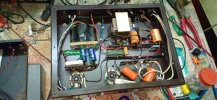
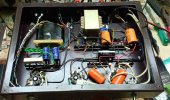
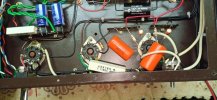
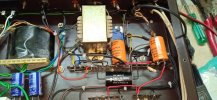
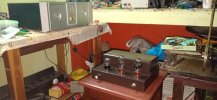
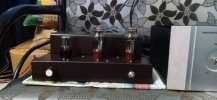
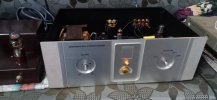
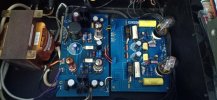
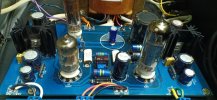
This 1626 tube is not costlier as 45 or 2A3 tubes, but 1626 sounds really very good. I am not telling 1626 will beat those tubes, each tube have its own unique sound signature. i surprised by the sound quality of this tube.
The amp is coupled with a 6SN7 tube preamp which is purchased from local market chennai, without tubes and some minor faults.
Both preamp amp and amp is delivered to customer.









Thanks Jeff for pitching in with your expert comments. I was fortunate enough to have you as my guide and mentor for my tube amp built, though I did not layout exactly as intended by you. But I have retained all key inputs from you regarding components selection, wires selection, layout of input tube and RCA, twisting of wires, not clubbing any wires for good looks etc.On the 300B amp, there are a few things you can do, to get better performance,........... for free.
1) Cut off all the tie wraps, where you have bundled wires, and throw them in the garbage. The tie wraps forces the fields of the tightly positioned wires to minutely interact with each other, and it rob's the circuit of it's best possible fidelity. The better the amp, and the better the audio system, the more this is evident. Wires should have space between them, even 1/8th of an inch, not touch, and cross at right angles to each other. This should make sense, if you are told and think about it.
2) You need to reposition the input RCA jacks. They are on the wrong side of the amp. You want input wiring to be no more than 2 to 3 inches long, from the RCA jack's center pin, to the grid of the input tube, or, in your case, the input of the Jensen Input transformer.
- - - - - - - - - - - - - - - - - - - - - - - - - - - - - - - - - - - - - - - - - - - - - - - - - - - - - - - - - - - - - - - - -
A general comment, tube amps that are low in overall sensitivity, should be avoided, as they will lack what is called " jump factor ". Obtaining a high input sensitivity, by going to a three stage SE amp , is always a design mistake. Why? Very simple, in my honest opinion, the extra ( middle ) stage loses information, no matter how well it is executed. This leaves us with two stage single ended or push pull tube amps, as always being the very best amp configuration possible.
Amps without a high " jump factor " sound slow and less mentally involving to hear, they have to be pushed to sound decent. What about low level listening? Well, they score C-, D+.
How much gain should one have, in a two stage tube amp, to have a decent " jump factor "??? Good question. Taking the rated ( and not made-good actual ) mu ( gain ) of the two tubes, if they multiply to about 400, you are in good shape. Less is a loss of jump factor !!!
How does one apply this, in real life tube amp design terms ? Well, a mu of 4 ( rated ) 2A3 needs a mu of 100 driver tube. Half a ( mu of 100 rated ) 12AX7 get us, when multipled by 4, "400". However, the 12AX7 is kinda whimpy. So, the better choice is half a 12BZ7 ( mu of 100, a more powerful tube ).
If using a pentode output tube, with a mu of about 12, typically a mu of 33 to 35 ( as the Driver tube choice ) will get us either " 396 or 420 " when multiplied, and that will be " on the money" as far as a satisfactory two-tube combination, with being involving - to - hear, jump-factor wise.
Back to my original comment, separating chassis wiring, eliminating tie wraps, and short distances between the RCA jack center pin, and the Input tube's grid, are always best in my opinion and experience, to plan on doing .
Have fun.
I have done this after your advise Jeff, and the sound had substantial improvement that could be easily noticed by removing the wire ties.You are most certainly welcome. When you eliminate the tie wraps, and spread the wires 1/8th an inch or more, ( Oh, pardon me, 3 mm. or more ) do an A-B, same music and same volume stetting, and tell us all if it plays a wee bit purer ( subjectively 1 to 2 % ). Have fun, and please do let us all know what you hear. Thanks.
Wharfedale Linton Heritage Speakers in Red Mahogany finish at a Special Offer Price. BUY now before the price increase.






